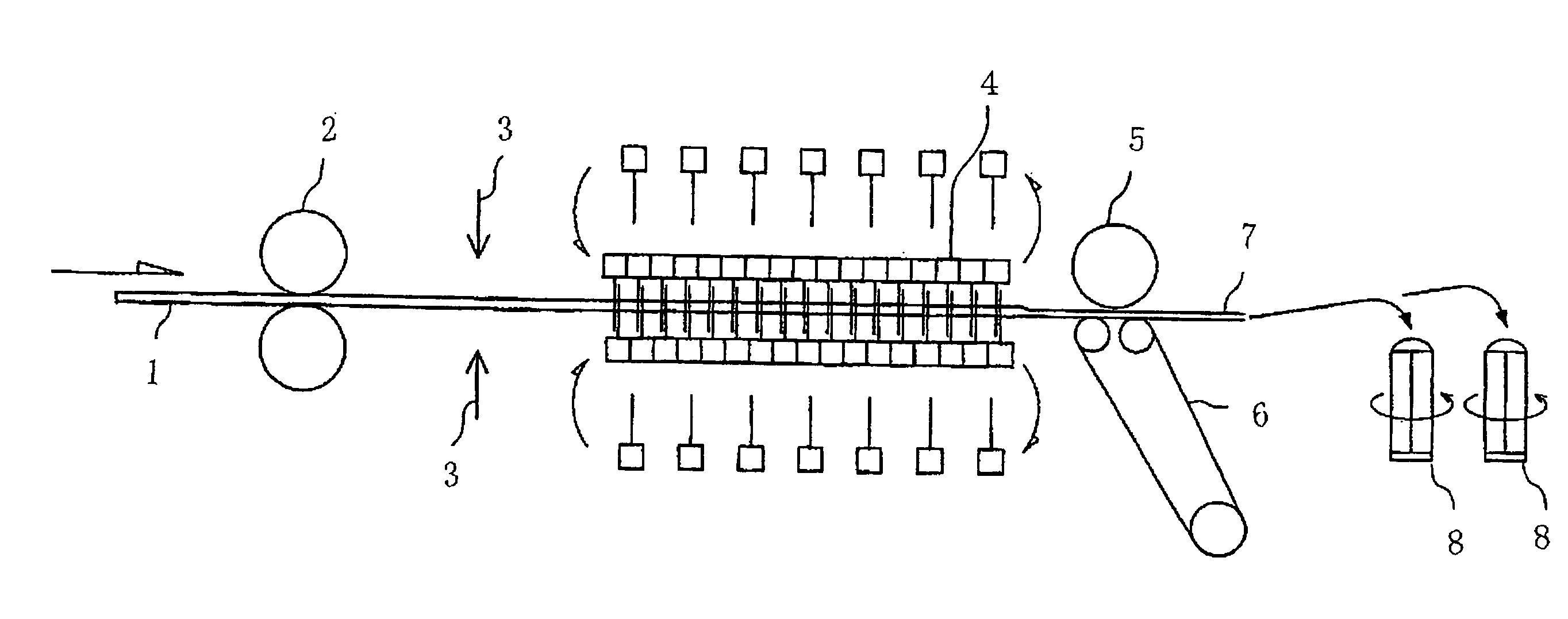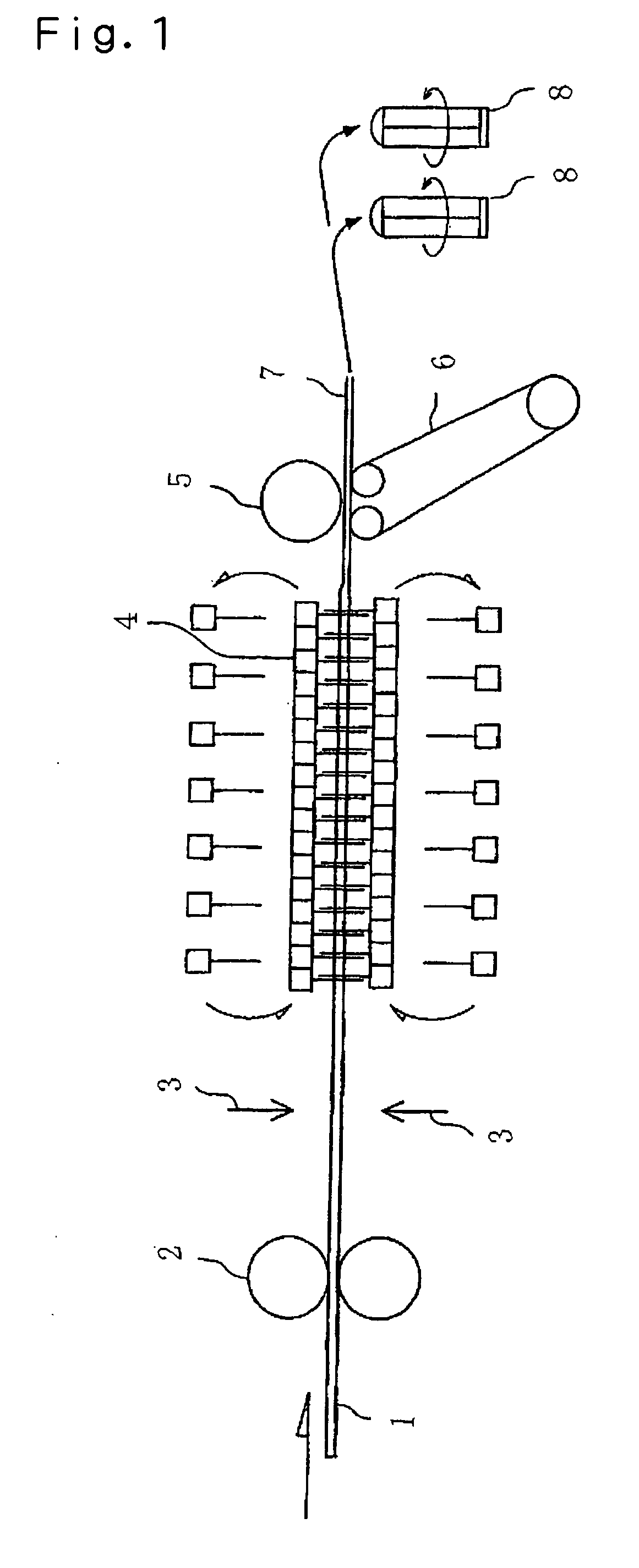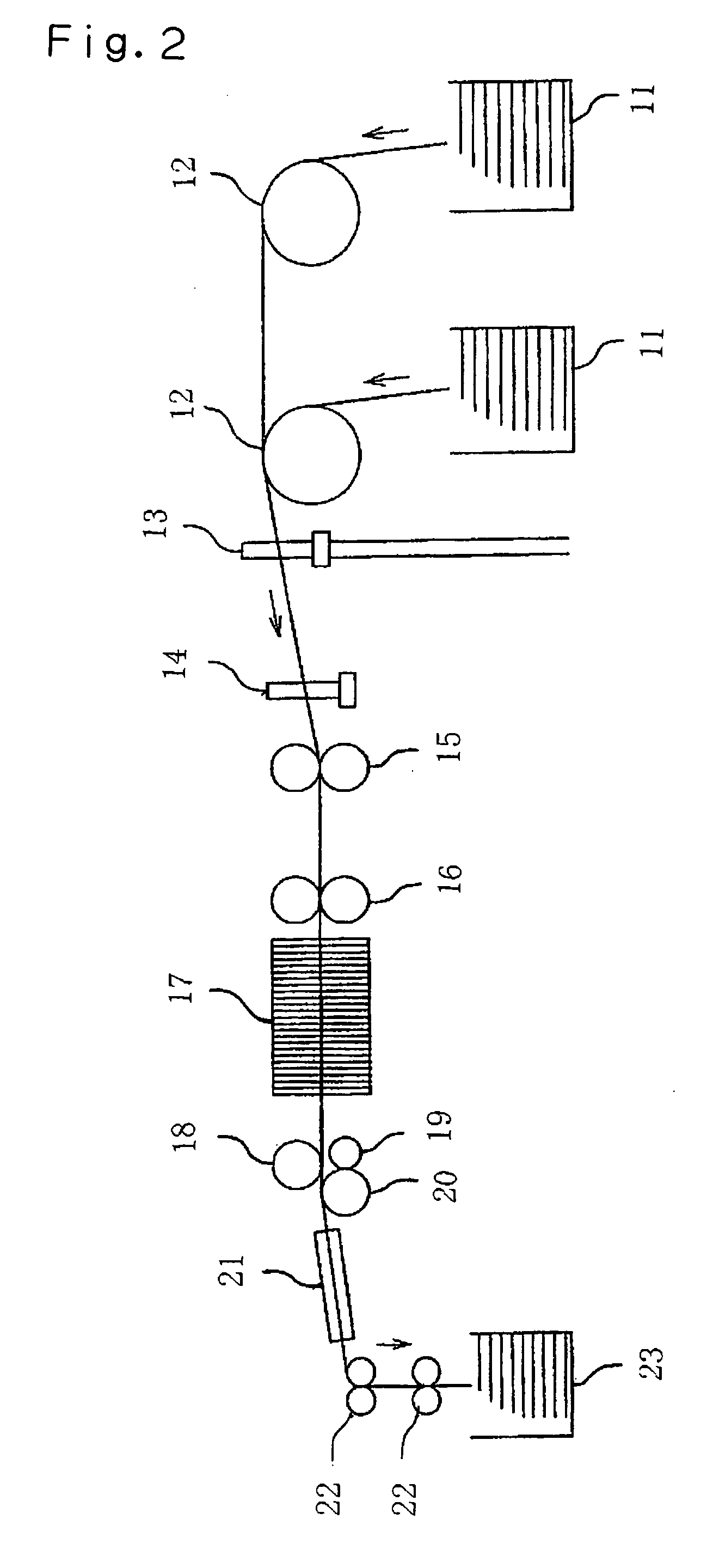Hybrid Carbon Fiber Spun Yarn and Hybrid Carbon Fiber Spun Yarn Fabric Using the Same
a hybrid carbon fiber and spun yarn technology, applied in the direction of sustainable manufacturing/processing, final product manufacturing, electrochemical generators, etc., can solve the problems of small aperture ratio (porosity), and poor contact with catalyst layers, so as to reduce adhesion and improve the uniformity of fineness , the effect of high tensile strength
- Summary
- Abstract
- Description
- Claims
- Application Information
AI Technical Summary
Benefits of technology
Problems solved by technology
Method used
Image
Examples
manufacturing example 1
Manufacturing a Pitch-Based Isotropic Carbon Fiber Bundle of 660 Tex, Heat-Treated at a Heat Temperature of 1000° C.
[0079]Pitch-based isotropic carbon fiber bundles (“KRECA Tow T-101S” made by KUREHA CORPORATION, 23 g / m) were used. In a drawing process using four drawing machines which were each assembled as shown in FIG. 2, two carbon fiber bundles of this type were combined together and drafted to 4.0 times with the first drawing machine to form a single carbon fiber bundle. Subsequently, two carbon fiber bundles of this type were combined together and drafted to 5.3 times with the second drawing machine to form a single carbon fiber bundle. Further, two carbon fiber bundles of this type were combined together and drafted to 5.3 times with the third drawing machine to form a single carbon fiber bundle. Moreover, two carbon fiber bundles of this type were combined together and drafted to 5.0 times with the fourth drawing machine to form a single pitch-based isotropic carbon fiber b...
manufacturing example 2
Manufacturing a Pitch-Based Isotropic Carbon Fiber Bundle of 920 Tex, Heat-Treated at a Heat Temperature of 1000° C.
[0080]Pitch-based isotropic carbon fiber bundles (“KRECA Tow T-101S” made by KUREHA CORPORATION, 23 g / m) were used. In a drawing process using four drawing machines which were each assembled as shown in FIG. 2, two carbon fiber bundles of this type were combined together and drafted to 5.0 times with the first drawing machine to form a single carbon fiber bundle. Subsequently, two carbon fiber bundles of this type were combined together and drafted to 5.0 times with the second drawing machine to form a single carbon fiber bundle. Further, two carbon fiber bundles of this type were combined together and drafted to 4.0 times with the third drawing machine to form a single carbon fiber bundle. Moreover, two carbon fiber bundles of this type were combined together and drafted to 4.0 times with the fourth drawing machine to form a single pitch-based isotropic carbon fiber b...
manufacturing example 3
Manufacturing a Pitch-Based Isotropic Carbon Fiber Bundle of 398 Tex, Heat-Treated at a Heat Temperature of 1000° C.
[0081]Pitch-based isotropic carbon fiber bundles (“KRECA Tow T-101S” made by KUREHA CORPORATION, 23 g / m) were used. In a drawing process using four drawing machines which were each assembled as shown in FIG. 2, a single carbon fiber bundle of this type was drafted to 5.0 times with the first drawing machine to form a single carbon fiber bundle. Subsequently, two carbon fiber bundles of this type were combined together and drafted to 5.0 times with the second drawing machine to form a single carbon fiber bundle. Further, two carbon fiber bundles of this type were combined together and drafted to 4.3 times with the third drawing machine to form a single carbon fiber bundle. Moreover, two carbon fiber bundles of this type were combined together and drafted to 4.3 times with the fourth drawing machine to form a single pitch-based isotropic carbon fiber bundle of 0.398 g / m ...
PUM
| Property | Measurement | Unit |
|---|---|---|
| length | aaaaa | aaaaa |
| length | aaaaa | aaaaa |
| density | aaaaa | aaaaa |
Abstract
Description
Claims
Application Information
 Login to View More
Login to View More - R&D
- Intellectual Property
- Life Sciences
- Materials
- Tech Scout
- Unparalleled Data Quality
- Higher Quality Content
- 60% Fewer Hallucinations
Browse by: Latest US Patents, China's latest patents, Technical Efficacy Thesaurus, Application Domain, Technology Topic, Popular Technical Reports.
© 2025 PatSnap. All rights reserved.Legal|Privacy policy|Modern Slavery Act Transparency Statement|Sitemap|About US| Contact US: help@patsnap.com



